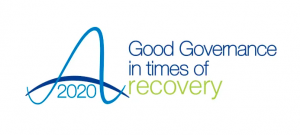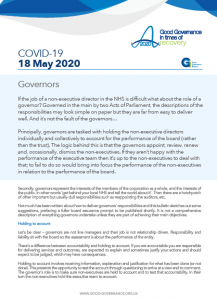Governors
18 May 2020

If the job of a non-executive director in the NHS is difficult what about the role of a governor? Governed in the main by two Acts of Parliament, the descriptions of the responsibilities may look simple on paper but they are far from easy to deliver well. And it’s not the fault of the governors...
Principally, governors are tasked with holding the non-executive directors individually and collectively to account for the performance of the board (rather than the trust). The logic behind this is that the governors appoint, review, renew and, occasionally, dismiss the non-executives. If they aren’t happy with the performance of the executive team then it’s up to the non-executives to deal with that; to fail to do so would bring into focus the performance of the non-executives in relation to the performance of the board.
Secondly, governors represent the interests of the members of the corporation as a whole, and the interests of the public. In other words ‘get behind your local NHS and tell the world about it’. Then there are a hotchpotch of other important but usually dull responsibilities such as reappointing the auditors, etc.
Not much has been written about how to deliver governors’ responsibilities and this bulletin sketches out some suggestions, prefacing a fuller board assurance prompt to be published shortly. It is not a comprehensive description of everything governors undertake unless they are part of achieving their main objectives.
Holding to account
Let’s be clear – governors are not line managers and their job is not relationship driven. Responsibility and liability sit with the board so the assessment is about the performance of the entity.
There’s a difference between accountability and holding to account. If you are accountable you are responsible for delivering services and outcomes, are expected to explain and sometimes justify your actions and should expect to be judged, which may have consequences.
Holding to account involves receiving information, explanation and justification for what has been done (or not done). This presents the opportunity to test the account through questioning to arrive at a view and to comment. The governor’s role is to make sure non-executives are held to account and to test that accountability. In their turn the non-executives hold the executive team to account.
Critical friend
Clearly, this cannot just be a paper exercise. Governors need to see non-executives in action at board meetings and also in committee where you are much more likely to see people’s real capabilities. The nervousness about inviting governors to committee meetings is ill-founded. If they are not prepared to be a critical friend – with the emphasis on friend – then they have no business being a governor. The code of conduct for governors and the confidentiality arrangements they sign up to match those of board members so there should be no issue sharing papers, discussions and insights with them. Governors will bring a different perspective and their views are as valid as anybody’s. At GGI when we are evaluating boards, we find the governors key informed witnesses who are able to give a view of board performance over time.
Setting up governor groups to offer their perspective on particular subject areas or for specific tasks offers opportunities for directors and governors to work together to solve trust issues and provide insights into the holding to account
As a governor, how should you assess this? The CQC looks at how well-led a trust is as a key part of its assessment and the criteria it uses are helpful to frame thinking:
- Consider the leadership capability and capacity of the board – is it visible and approachable?
- Does the board show clear vision and a credible strategy, built from a good design process and are discussions driven from the strategy?
- Is there an evident and palpable culture of high quality care – does the board take notice of what patients and staff are saying?
- Are responsibilities clear – are there roles and systems in place and in use to promote good governance?
- How well is risk managed – are strategic risks linked to strategy and is the board assurance framework a driving force for the work of the board?
- Does the board deal with data or information – are they being given the wherewithal to make informed decisions that can be challenged and acted on?
- Is there a yearning to learn – are innovation, improvement and development running through the veins of the organisation? How open is the culture as evidenced by people’s willingness to report incidents, speak out and tell it how it is, safe in the knowledge that there will be a positive response?
Representation
If holding to account is difficult, that’s nothing compared with representing the interests of the members of the trust and the public. This is best seen as a joint endeavour between the trust and the governors. Foundation trusts have the equally challenging responsibility in statute to develop a membership reflecting the make-up of their communities. In multi-cultural areas of the country this is quite a task. It is always a challenge to get younger people, indeed people of working age, involved. We see very varied attempts to engage with the so-called ‘hard-to-reach’ voices. Some trusts and governors groups are much more imaginative about discharging their responsibilities than others. Not all trusts make meaningful resources available to governors to enable this element of their role.
Most trusts have a newsletter in physical and electronic form and offering governors space to talk about themselves and what they are doing can be invaluable as can taking a step further and offering an insert covering governor matters.
Others run governor working groups dealing with membership development. Devising a membership strategy offers something measurable and acknowledges the value the trust places on developing its membership. After all, the NHS is the people’s service and engagement lies near the heart of providing good services.
One trust sponsored a dietician to find a way into a hard-to-access community, by offering healthier cooking tips. Over time this led to an increase in membership from this group and eventually to one of them being elected as a governor. Finding connections is something governors, from the heart of their community, can do and it will help them to represent the interests of their communities and then tell them about it while at the same time helping the trust to build a membership to reflect those it serves.
Call to action
Governors are here to stay and non-foundation trusts can expect to be asked to extend their community involvement on the back of the pandemic – and the national mood makes it a good time to do this.
Embracing the concept with all its challenges is overdue and some of the suggestions in this bulletin could make a huge reputational difference.
When seeking to engage with a community, first consider their interests and what is important to that group of people, at that specific time, before seeking engagement on bilateral issues.
Governors could also consider developing a social media strategy to help reach out to local charity and community groups. Some governors use their personal social media accounts to spread news and garner views. A good social media strategy (and policy) would enable a more systematic approach to an increasing means by which the public gain information and offer opinion.
We are preparing a much more detailed exploration of these issues now and are keen to hear your views. If this briefing prompts any questions or comments, please call us on 07732 681120 or email advice@good-governance.org.uk.

